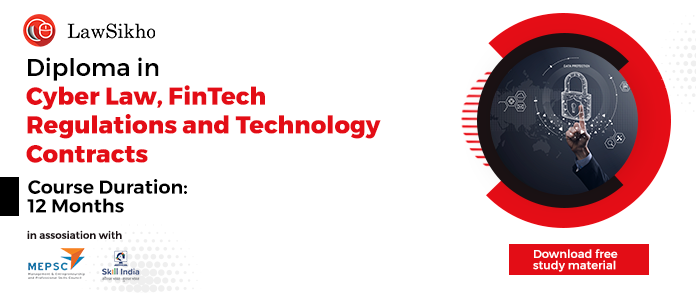This article has been written by Khushi Oberoi, pursuing a Certificate Course in Introduction to Legal Drafting: Contracts, Petitions, Opinions & Articles and has been edited by Oishika Banerji (Team Lawsikho).
It has been published by Rachit Garg.
Table of Contents
Introduction
A “contract” is a document which includes two or more parties agreeing on written clauses. A contract is termed for a specific period of time once the work has been done, the contract will be terminated. A ” software contract” is a contract between two parties where one party is the “software provider” who lays out all the obligations required by the other party i.e; “software user”. The software provider is the software company who allows the software user to access the software for a period of time on the terms contract and the user can access the software until the contract is terminated or ends. This article discusses software contracts and all other related aspects to it.
What does a software contract imply
A software contract implies that an owner grants the right to create, view, and revise the contract’s record with software contract applications. To create a software contract, the software provider will send an order form or any document in which the business terms and conditions will be laid out such as how frequently you will be paying, how much you are paying and other commercial details. Before signing any document, it must be read carefully and one should know what they are signing. The software user and the provider has the liberty to add the clauses as per their requirements but both the parties have liberties to accept or reject the clauses which according to them does not fit.
Ownership
Ownership will be possessed by the software company. Only the access will be granted to the buyer that too for a limited period of time mentioned in the contract.
Associated licence
The licence can be associated by three line items in which one can be selected.
- Associate by Software Product
Click on “associate by software product ” to select from the list that are associated with the software product.
- Associate by Vendor
Click on ” associate by vendor” to select from the list that are associated with lists of vendors.
- Associated License
Click on “associated License ” to select the list of available licences.
Features of software contracts
There are 5 elements of software contracts. They are:
- Usage and restrictions
This specifies the user what are his rights and restrictions. The customer cannot licence,sell or rent his non-transferable rights or licence to another person.
- Ownership
This specifies that the software company is the owner of the software.The software company grants the usage and rights to the buyer. The company does not grant any right of ownership to the buyer.
- Term and Termination
This specifies the validity of the contract. It will include the details of what occurs when the contract is terminated or ends, what occurs if any of the parties end the contract before completion. It includes “terms” which means guidance for the termination of the contract.
- Fees and payment
This specifies the mode of payment. It includes the currency ( INR or USD) and at what time the payment has to be made.It also includes clauses related to late fees, instalment and payment after completion of the work.
- Indemnification
The term “Indemnity” means when one party suffers any loss or damage, the other party will pay for their losses. For eg: Insurance company insures the insured that if they suffer any loss, the insurance company will pay for them. The software contract includes clauses in which if the party suffers any loss such as hacking or data leak or breach of contract, the customer or buyer can sue the software company for their loss.
Software contracts : a judicial insight

- Infotech dealer vs Union of India (2010)
In this case, it was held that this case relates to “End User Licence Agreement (EULA)” and the court dismissed the writ petitions holding that the software is goods and whether the transaction would amount to sale or service would depend upon the individual transaction and for the reason of that challenge, the amended provision cannot be held to be unconstitutional so long as the Parliament has the legislative competency to enact law in respect of tax on service in exercise of powers under Entry 97 of List I of Schedule VII.
- The Commissioner of Income tax vs Zte corporation (2021)
In this case, it was held that buyer is hereby granted a limited, non-transferable, perpetual, non-exclusive licence to use the software and documentation provided pursuant to the contract. In terms of the contract between the assessee and the customers, the buyer has no title or ownership rights.
- KILITCH Drugs Ltd vs M/S Base Information Management (2011)
In this case, it was said that the contract by which the user received the said software as licence requested the opponent to cancel the licence and refund the payment made by them against the contract under which the complaint was made was proved to be erroneous.
These cases set an example that a contract must be read with all the terms and conditions prior to signing them. To prevent any mistake or misunderstanding, one can add a clause of witnesses so that if something is missed by the contractual party, the witness can catch the defaults and prevent any damage or loss to the user or the contractual party.
Therefore, the five elements must be read carefully and if there is any doubt, the user can consult the legal consultant to guide them about the benefits and losses they are getting from each clause. If the user is not acceptable with any clause, with the guidance of the legal consultant,the clause can be omitted or excluded from the contract with the agreement of both the parties.
Note:These are the 5 elements which need to be read before signing the software contract.
If the user is not thorough with the clauses before signing, he cannot claim for compensation or breach of trust by the providers as here he will be held liable for his negligence. The software user can negotiate before it approaches the delivery date, after the delivery there can be no negotiation as the negotiation can be done before completion of the work as per the contract. If required the user can cancel the contract by negotiating by including the clause “termination for convenience “.
Conclusion
The software contract is a contract entered between the software provider and software user firm. It’s a type of contract which must follow Section 10 of Indian Contract Act, 1872. All the terms and conditions must be read before signing the contract. Once signing the contract, the parties can terminate the contract by agreement and mutual decision. Therefore, the software contracts deals with three main words, namely, signed, sealed and delivered. The damage related to breach of contract or any misrepresentation or fraud related to software or contract are mentioned in Information Technology Act 2000.
References
- https://itatonline.org/archives/infotech-software-dealers-association-vs-uoi-madras-high-court-though-software-is-goods-its-supply-may-be-a-service-and-not-a-sale/.
- https://www.casemine.com/judgement/in/5909e3724a932663936b89bc.
- https://track.g2.com/resources/software-contracts
Students of Lawsikho courses regularly produce writing assignments and work on practical exercises as a part of their coursework and develop themselves in real-life practical skills.
LawSikho has created a telegram group for exchanging legal knowledge, referrals, and various opportunities. You can click on this link and join:
Follow us on Instagram and subscribe to our YouTube channel for more amazing legal content.












